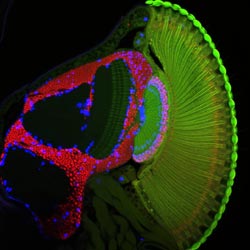Partnership of genes affects the brain's development

The photoreceptor nerve cells (green) of the fly\'s compound eye send their axons to the brain\'s optic ganglia. Scientists have now discovered that the axons are able to recognize their target area in the brain thanks to the interaction of two genes. Credit: Max Planck Institute of Neurobiology / Suzuki<br>
Scientists of the Max Planck Institute of Neurobiology in Martinsried have now shown that growing nerve cells realise when they've reached their target area in the fly brain thanks to the interaction of two genes. Similar mechanisms are also likely to play a role during the development of the vertebrate brain and could thus be important for a better understanding of certain developmental disorders.
The nervous system is incredibly complex. Millions and even many billion nerve cells are created during development. Each of these cells sets up connections to their neighbouring cells and then sends out a long connecting cable, the axon, to a different brain region. Once the axon has reached its target area it connects itself with the local nerve cells. In this way a processing chain is established which allows us, for example, to see a cup, recognize it as such, reach out and take hold of it. Had there been a misconnection between the nerve cells somewhere along the way between the eyes and the hand, it would be impossible to reach the coffee in the cup.
It is thus essential for nerve cells to connect to the correct partner cells. Based on this fact, scientists of the Max Planck Institute of Neurobiology in Martinsried and colleagues from Kyoto investigated how an axon knows where it should stop growing and start setting up connections with surrounding cells. For their investigation, the neurobiologists analyzed the function of genes that play a role in the development of the visual system of the fruit fly.
The scientists now report in the scientific journal Nature Neuroscience that the visual system of the fruit fly is only able to develop correctly, when two genes work together – the genes, that are in charge of producing the proteins “Golden Goal” and “Flamingo”. These two proteins are located at the tip of a growing axon, where they are believed to gather information about their environment from the surrounding tissue. The actions of these two proteins enable nerve cells in a number of ways to find their way in the brain and recognize their target area. The study showed that chaos results if only one of the genes is active, or if there is a mismatch in the genes' activity: the axons cease to grow somewhere along the way and never reach their target area.
“We assume that very similar mechanisms play a role also in other organisms – including humans”, explains Takashi Suzuki, lead author of the study. “We are now a good way into understanding how to manipulate the cells in such a way that they are certain to reach their target area.” This knowledge would be an important foundation for eventual therapies of developmental disorders based upon a misguided growth of nerve cells. The knowledge may also help in the guidance of regenerating nerve cells back to their old connection sites.
Original publication:
Hakeda-Suzuki S*, Berger-Mueller S*, Tomasi T, Usui T, Horiuchi S, Uemura T, Suzuki T (*equal contribution)
Golden Goal Collaborates with Flamingo in Conferring Synaptic-Layer Specificity in the Visual System Nature Neuroscience,February 14 2011
Media Contact
More Information:
http://www.neuro.mpg.deAll latest news from the category: Life Sciences and Chemistry
Articles and reports from the Life Sciences and chemistry area deal with applied and basic research into modern biology, chemistry and human medicine.
Valuable information can be found on a range of life sciences fields including bacteriology, biochemistry, bionics, bioinformatics, biophysics, biotechnology, genetics, geobotany, human biology, marine biology, microbiology, molecular biology, cellular biology, zoology, bioinorganic chemistry, microchemistry and environmental chemistry.
Newest articles

Silicon Carbide Innovation Alliance to drive industrial-scale semiconductor work
Known for its ability to withstand extreme environments and high voltages, silicon carbide (SiC) is a semiconducting material made up of silicon and carbon atoms arranged into crystals that is…

New SPECT/CT technique shows impressive biomarker identification
…offers increased access for prostate cancer patients. A novel SPECT/CT acquisition method can accurately detect radiopharmaceutical biodistribution in a convenient manner for prostate cancer patients, opening the door for more…

How 3D printers can give robots a soft touch
Soft skin coverings and touch sensors have emerged as a promising feature for robots that are both safer and more intuitive for human interaction, but they are expensive and difficult…





















